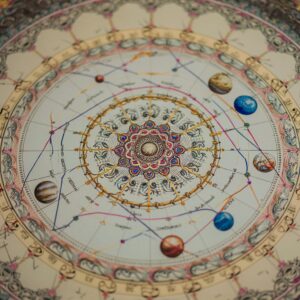Reading a birth chart, also known as a natal chart, involves analyzing the positions and relationships of celestial bodies at the exact time and location of a person’s birth. Here’s a step-by-step guide:
- Determine the person’s exact birth date, time, and location. The more precise the information, the more accurate the birth chart will be.
- Draw up the birth chart using an online chart calculator or astrological software. The chart will show the positions of the Sun, Moon, planets, and other celestial bodies at the time of the person’s birth.
- Identify the person’s Ascendant, or Rising Sign, which is the sign that was on the eastern horizon at the moment of their birth. The Ascendant sets the stage for the rest of the chart and represents the person’s outer persona and approach to the world.
- Look at the placement of the Sun, which represents the person’s core identity and life purpose. The sign and house placement of the Sun can give clues to the person’s strengths, weaknesses, and areas of focus in life.
- Examine the Moon’s placement, which represents the person’s emotions, habits, and inner life. The sign and house placement of the Moon can provide insight into the person’s emotional needs and how they experience and express their feelings.
- Consider the positions of the other planets, including Mercury, Venus, Mars, Jupiter, Saturn, Uranus, Neptune, and Pluto. Each planet represents different aspects of the person’s personality, life experiences, and areas of growth.
- Look at the relationships, or aspects, between the planets in the chart. These can show how the different parts of the person’s personality interact with each other, as well as highlight potential areas of tension or harmony.
- Take note of any significant patterns or configurations in the chart, such as a stellium (three or more planets in the same sign or house) or a grand trine (three planets forming an equilateral triangle in the chart). These patterns can indicate areas of focus or potential challenges in the person’s life.
- Finally, use your knowledge of astrology to interpret the chart in light of the person’s life experiences and current situation. Remember that astrology is not deterministic, but rather a tool for self-awareness and understanding. The birth chart can provide insights into the person’s strengths, challenges, and potential for growth, but ultimately it is up to the individual to make choices and chart their own path in life.
- Pay attention to the houses in the chart, which represent different areas of life. For example, the 1st house represents the person’s physical appearance and approach to the world, the 2nd house represents money and possessions, and the 7th house represents relationships. The sign on the cusp of each house and any planets that fall within the house can give further insight into the person’s experiences and priorities in that area of life.
- Consider the elements and qualities of the planets in the chart. The elements (fire, earth, air, water) and qualities (cardinal, fixed, mutable) can reveal more about the person’s temperament and tendencies. For example, a person with a lot of planets in fire signs may be energetic and passionate, while a person with many planets in earth signs may be practical and grounded.
- Look for any planetary aspects that involve the Ascendant or Midheaven (the highest point in the chart). These can indicate significant events or turning points in the person’s life, as well as shed light on their overall life path.
- Take note of any retrograde planets in the chart, which appear to be moving backwards in the sky. Retrograde planets can indicate areas where the person may experience setbacks or have to revisit lessons from the past.
- Consider the overall balance of the chart, including the distribution of planets across the signs and houses. An imbalanced chart may indicate areas of overemphasis or neglect in the person’s life.
- Remember that astrology is playing role of advisor or guide. With this help birth chart can provide valuable insights into a person’s personality and life path, it should be used in conjunction with other forms of self-exploration and self-care and practicality.
In conclusion, reading a birth chart involves analyzing the positions and relationships of celestial bodies at the time and location of a person’s birth. By examining the placements of the Sun, Moon, planets, and other celestial bodies, as well as the aspects and patterns in the chart, astrologers can gain insights into the person’s personality, life path, and potential for growth. However, it’s important to remember that astrology is not deterministic and should be used as a tool for self-awareness and understanding, rather than a set of rules or predictions. Additionally, it’s important to seek professional advice and medical treatment when necessary, as astrology is not a substitute for these forms of support.







